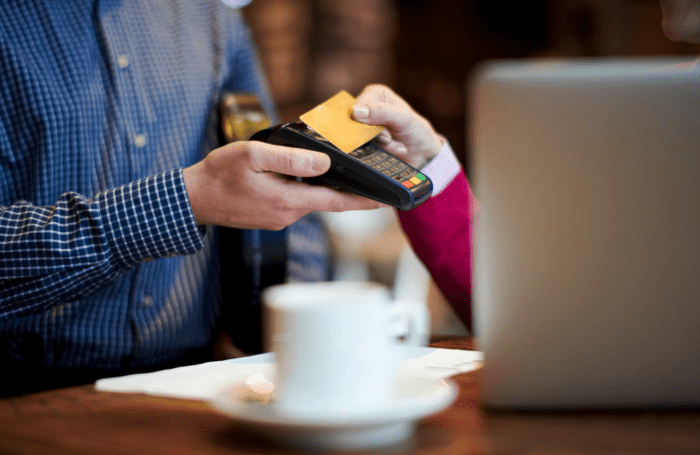Contactless payment: simple and safe
25 January 2022 - 7 min Reading time
More and more people are paying contactless. For small and large amounts, they hold their payment card against the terminal in the store, enter their PIN code or not and the payment is made. It's easy and super fast. But is it also safe? Some people seem to doubt that. Unjustly.
The form of fraud, as shown in the Factcheckers program, in which someone can rob people via a wireless payment terminal by holding the device unnoticed against the pocket or handbag, has often been described in the press and on social media, but in practice very unlikely.
The potential loot is very limited and the chance of catching and traceability of the scammer is very high. The return that this form of fraud can generate is so small in relation to the risks for the fraudster that this hardly ever occurs. We also have no knowledge of incidents in Belgium.
Moreover, as a consumer you are well protected if there is any question of fraud via a contactless payment, your bank will always refund the lost sum (subject to the investigation), unless there is fraud on the part of the customer.
Contactless payment is and remains a user-friendly and safe way of paying. This is also confirmed by the large share of payments that are made contactless (57%), and the confidence people have in this.

Identification of the fraudster
It is not possible to simply purchase a payment terminal and use it to carry out transactions unseen. For this, the merchant must conclude a contract with an acquirer. The acquirer is the financial institution that processes card payments for a merchant and also pays them. This acquirer is required to go through a 'Know Your Customer' process for each merchant, which means that it will thoroughly verify the customer's identity. After the fraudulently executed transaction, it is therefore easy for the acquirer (and pre-eminently the police) to trace the identity of the fraudster.
Limited loot
The potential loot is also very limited. Without the cardholder's personal pin code, a maximum amount of EUR 50 per transaction can be withdrawn from the victim's account. Moreover, that amount is very uncertain, given that the fraudster does not know what the victim's account balance or state of expenditure is.
After all, in addition to the limit of 50 euros per transaction, we also know the cumulative limit for consecutive payments without a PIN code (100 or 150 euros depending on your bank). If this limit is exceeded, the personal PIN - the necessary condition to exceed this limit - will be requested. In that case, the thief has no loot.
The above limits were set by the second Payment Directive (PSD2) and try to maintain a balance between security and ease of use.
Limited feasibility
In addition, a payment card is often found among other cards in a wallet that also have an integrated chip with contactless functionality, which makes the connection between the chip of the contactless card in question and the fraudulent terminal more difficult. In addition, the card must be held almost against the terminal for a contactless transaction to succeed. Due to its limited feasibility, this form of fraud does not often lead to a successful transaction.
The potential loot is therefore very limited and the chance of catching and traceability of the scammer is very high. The return that this form of fraud can generate is so small in relation to the risks for the fraudster that this hardly ever occurs. We also have no knowledge of incidents in Belgium.
Many contactless payments, hardly any reports of fraud
Contactless payment is becoming more and more commonplace and we have virtually no reports of fraud using the contactless payment card in Belgium. This is striking because the share of contactless payments in our country has risen sharply in the last two years: our figures show that in December 2021, 57.70% of all debit card payments in a store were contactless. In comparison, in February 2020 it was only 16%. That is more than a threefold increase in less than two years.
This frequent use of the contactless payment card in combination with the absence of fraud reports shows that this is a very user-friendly and safe way of paying. The customer's confidence is therefore justified.
This also makes it a worthy and perhaps even better alternative to cash. After all, if you lose your wallet or if it is stolen, you have lost the cash that was in it. With contactless cards, the chance of stolen funds is reduced and there is also a limit on the amount you can potentially lose. In addition, there is a protective framework to recover this loss.
Contactless payment: how does it work?
- Do you pay less than or just 50 euros? You hold your card against the terminal to pay and within a few seconds you have paid.
- Do you pay more than 50 euros? No problem! You hold your card against the terminal, which will then ask you to enter your PIN code.
- If you make several consecutive contactless payments of a maximum of 50 euros (without a pin code) and exceed a total amount of 100 or 150 euros* (for example 10 euros + 45 euros + 25 euros + 25 euros), you must enter your pin code. After that it is again possible to pay contactless without a PIN code.
(*) Some banks apply a cumulative limit of 100 euros, others of 150 euros (the legal maximum).
And what if something goes wrong?
If money is debited from your account if, for example, your card is stolen or if you lose your card and someone has made a contactless payment (without PIN code) with your card, the bank will always refund the lost sum (subject to the investigation), unless there is fraud on the part of the customer.
The customer is responsible for having his payment card blocked as soon as possible via Card Stop (+32 78 170 170) in the event of loss or theft. For example, contactless transactions without a PIN code will also become impossible.
